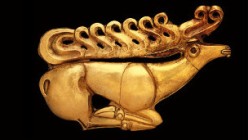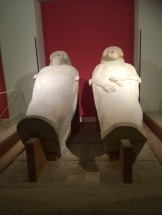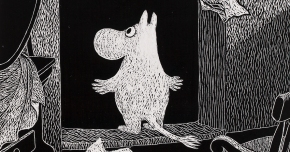Ylva111's Blog
All that glitters is gold at the Scythians
Leave a Comment
 Gold objects dominate the British Museum exhibition about the Scythians. Many of us had never heard of these Nomadic people who roamed the steppes of Russia and what is now Ukraine in 500 to 300 BC. Beautifully displayed in the new exhibition centre at the BM the gold glitters and seduces.
Gold objects dominate the British Museum exhibition about the Scythians. Many of us had never heard of these Nomadic people who roamed the steppes of Russia and what is now Ukraine in 500 to 300 BC. Beautifully displayed in the new exhibition centre at the BM the gold glitters and seduces.
How did they do it and where did the gold come from? It seems that most of this was river gold, found in the streams and rivers of the Ural Mountains. And although some credited Greek craftsmen with the delicate work, it’s clear from more recent finds that the Scythians themselves didn’t just ride horses, plunder and drink – apparently copiously – but they also had time, the skill and patience to create these wonderful objects. Many were decorations for the bridle of their horses, others for the belts worn by men. Tiny little replica objects were also made for their graves.
So you have till the 14th January to see this amazing exhibition with its selection of gold mostly from St Petersburg’s Hermitage collected during the time of Peter the Great.
And of course your blogger knows all about him after her visit to St Petersburg last year and the story of his immense memorial. The Tsar is sculpted on his horse which is raised on a monumental rock. It was Catherine the Great who commissioned this work, and it took hundreds of men and several years to bring the large boulder to St Petersburg, basically dragging it along the frozen ground on metal tracks. www.bm.ac
Museum of Cadiz
Your blogger was already on a pre-historic search after visiting the Museum of Cadiz in Southern Spain, particularly the archaeological exhibition on the ground floor. From this emerges a history going back to the Phoenicians who roamed the Mediterranean not by horse, of course, but by boat. Cadiz had an excellent harbour and became one of the first cities along the coast, linking the inland sea with the coast of Africa, and northwards the Atlantic coast. Columbus started his second exploration from here to what he still thought was India but in fact was the Caribbean islands and America beyond.

The Phoenicians pre-dated the Greeks and were active from 1200 to 800 BC. In the Museum there are two imposing sarcophaguses discovered during building work in Cadiz. The first was discovered as early 1887 during works on the city’s shipyard, the second more recently featuring a female ruler. The finely carved sarcophaguses have been restored and objects found are displayed nearby include a set of false eyelashes in copper for the queen. Most of the text is only in Spanish – so take a Spanish-speaking friend to this museum.
Moomins at the Dulwich Picture Gallery
Visiting the Dulwich Picture Gallery is always a pleasure and the current special exhibition took your blogger back to her childhood in Sweden. Tove Jansson’s famous Moomins – a family of mainly benevolent creatures – allowed Tove Jansson to explore her talents as an illustrator as well as story teller – with the added bonus of a dry sense of humour. The exhibition shows how she started as a painter before she concentrated on her drawing skills. She also wrote novels based on her life, particularly in the Finnish archip elago.
elago.
This year Finland celebrates 100 years as an independent state, previously ruled by Sweden and also Russia. Tove was herself part of the Swedish-speaking minority and wrote her books, and cartoon strips in Swedish. There is still time to see the exhibition which finishes on 28 January. http://www.dulwichpicturegallery.org.uk
And now for Christmas and New Year…..best wishes to all my followers and look out for my blog in 2018.
More from me at my website to ylvafrench.co.uk
Take a trip to Stockholm…..
Leave a Comment
The best part about a trip to Stockholm in the summer is the chance to explore the famous archipelago. Cruise ships and regular liners thread their way through the maze of hundreds of islands like huge icebergs and around them dart innumerable sailing and motorboats. But there is no need to take a boat, there are plenty of places for those on land to enjoy the spectacle.
Edmund de Waal in the Swedish archipelago
No doubt Edmund de Waal, writer and ceramicist, was thrilled to explore the space at the outlying gallery Artipelag which you can reach by ferry, car or bus. The dramatic setting with fir trees, cliffs and sea contrasts with de Waal’s delicate ceramic. A visit here is not complete without a walk around the gallery – and of course lunch in the café.
Surprise find at Prince Eugene’s Valdermarsudde
You can also explore the archipelago from Djurgården, reached by ferry, tram or a walk across the bridge from Strandvagen. Here is the original home of Prince Eugene, an artist; his home is now an art gallery. Set back above the main route into Stockholm harbour, the grounds provide wonderful views of incoming and departing ships.
The Mansion was built for the Prince in 1905 and designed by the well-known Swedish architect Ferdinand Boberg. As well as visiting seeing his home as it once was, there is an art gallery extension. This summer I went to see the exhibition of paintings and ceramics by the artist Anja Notini – Rooms with Gravitation – a series of abstracts created in response to nature. (It was something of a surprise when I found out that we were related – she is a second cousin.)
Anders Zorn’s portraits and Finnish glass at Kulturhuset
Away from the harbour but in a parkland setting is Sven Harrys a Vasaparken. This time they were showing some of Zorn’s outstanding portraits. (Zorn himself was a lover of the sea (and women), creating numerous paintings of young Swedish girls bathing!) This exhibition is now closed but the exciting news is that Zorn is the subject of a major exhibition in Paris this autumn at the Petit Palais opening on 15 September.
I also visited to Kulturhuset – not my favourite building in Stockholm – typical 60s/70s stark architecture. Not helped by a huge building site outside as they rebuild Sergels Torg. This time there was an exhibition of Finnish design starting with the works of architect Alvar Alto and then exploring his followers working in wood and producing decorative objects in glass. This inspirational display was staged by the National Museum of Sweden as part of its outreach work while it is still in redevelopment – due to re-open in the autumn of 2018.
No visit to Stockholm in August is complete without the Crayfish Party – this time at Anna’s.
https://artipelag.se/ https://www.waldemarsudde.se/in-english/
http://www.sven-harrys.se/en http://www.nationalmuseum.se/
http://www.petitpalais.paris.fr/en/expositions/anders-zorn
Great art at National Gallery and hidden gems at Longford Castle
Leave a Comment
Great art at the National Gallery
Michelangelo and Sebastiano, the new exhibition at the National Gallery, can be enjoyed on several levels. The art historian will relish the opportunity to discover the way the two artists worked together and the influence of Michelangelo on the Venetian artist Sebastiano de Pombo. He had arrived in Rome as Michelangelo was busy on the Sistine Chapel in 1511. Soon they became friends and there are letters between the two of them translated into English for visitors to study. Michelangelo provided the younger Sebastiano with drawings and on display are some of their collaborative works.
Those who just come to see some stunning artworks will not be disappointed either, although many are familiar from the National Gallery collection. The Royal Academy’s Taddei Tondo had moved here for the exhibition which continues until 25 June. Using the Gallery’s North galleries rather than the exhibition space in the Sainsbury Wing, provides headroom for the larger than life-size marble statue of the Risen Christ by Michelangelo and the three dimensional recreation of the Borgherini Chapel from S Pietro in Montorio, Rome.
This is mostly religious art, with the occasional portrait, created for worship and as tribute to the Creator to be displayed in chapels and churches. Every effort has been made here to give the artworks space, effective lighting and useful information, and to create in these galleries some of the atmosphere in which they were originally shown.
https://www.nationalgallery.org.uk/
Longford Castle – a hidden gem
Most people have never heard of Longford Castle but there it is hidden away just a few miles outside Salisbury. It started life as an Elizabethan Manor house on the river Avon but thanks to the treasures in a Spanish galleon wrecked in 1588 and a beautiful and enterprising Swedish noblewoman, Helena Snakenborg it became much more. The new home she planned with her second husband Thomas Gorges, took on the appearance of a moated, almost romantic Swedish castle with three substantial towers at each of the three corners. The triangular courtyard was later glazed over by one of the successive owners – since 1717 the Bouveries, a wealthy Huguenot family, ennobled as the Earls of Radnor.
Your blogger arrived on a tour of the castle organised by the National Gallery which has a close connection with the family. The famous painting The Ambassadors by Holbein is just one of works now at the National Gallery which was once owned by the family. But there is plenty left to see in this beautifully furnished and lived-in castle with a view of the garden and grounds from every window.
Our excellent guides led us on a tour not just to see the Gainsboroughs – one in every room – but many portraits by Reynolds and Van Dyck. Among the more unexpected works, I spotted a portrait by Elisabeth Louise Vigee-Lebrun of the third Earl as a young man, another portrait by Angelica Kauffman, a skating scene by Hendrick Avercamp, another full length portrait by Rubens, and one by Geerharts of Queen Elizabeth. The Picture Gallery on the first floor has a Claude Lorrain landscape at either end and is filled with treasures. These include a work partly by Rubens of the Monastery of the Escorial which had belonged to Charles I, and a stunning Correggio (now reattributed to Cambiaso) of Venus and Cupid. And there is more….I haven’t even mentioned the furniture or the porcelain.
To visit Longford Castle, go to the National Gallery website, although many of the limited tour dates are now fully booked.
Read more about Helena Snakenborg and her arrival in England on my website and find out more about my books including Finding Veronese and the newly launched The Go Around both available as E-books on Amazon and the Family Gronstedt’s history in Swedish at http://www.ylvafrench.co.uk
Goat with a tyre and other London treats
Leave a Comment
Spring is definitely in the air with daffodils in full bloom in London’s parks, and also at the rather grey and stony Paternoster Square in the City, as I discovered on a wander. In fact it was a promotion for Marie Curie – a most worthy cause – but they weren’t all real!
At Tate Modern the Rauschenberg exhibition is still attracting visitors as it draws to a close in early April. This is a mega selection from his long career and includes many of his well-known works such as the Goat with a tyre which has been lent by the Moderna Museeet in Stockholm. It was developed in the 1950s from a stuffed goat the artist found in a second-hand shop in New York.
Tate Britain, as predicted, is bursting at the seams with Hockney fans – well worth the effort to get a ticket. Some people love the portraits, others prefer the Yorkshire landscapes. So there will be something there for everyone.
Looking back to the 1930s
More challenging are the two exhibitions at the Royal Academy and they make a good match – maybe not on the same day. There is a lot to digest, particularly in the Russian exhibition in the main galleries. In the Sackler Wing the small but exquisite exhibition covers the impact of the depression on American art in the inter-war years.
Revolution: Russian Art 1917-1932 took me back to my visit to St Petersburg in September last year when with our Russian Martin Randall guide we spent several hours at the Russian Art Museum. The RA has brought together iconic artworks from there and also from private collectors to illustrate the post-revolutionary period by Chagall, Kandinsky and Malevich including posters, porcelain and photographs. Short film snippets show life in collective housing and on the land. There’s even a mock-up of what a small flat might have looked like. In a country where many still could not read, the propaganda value of revolutionary art was soon realised and used on the sides of trains travelling through the vast countryside.
America after the Fall: Painting in the 1930s while much smaller also pulls a punch with its evocative paintings of despair as Western economies plunged into depression after the Wall Street crash in 1929. Grant Wood’s picture of the cheerless American couple in “American Gothic” is the highlight of the exhibition. But every painting in this show really does tell a story….so linger and explore. You may even spot Lenin’s face in one of the paintings.
Family memories of the depression
In my Swedish book about Family Gronstedt, the depression played its part. My maternal grand-father was not just a doctor but also an investor in property and shares. A few years after the Wall Street crash which reverberated round European capitals, the Swedish “match king”, Ivar Kreuger, took his own life in Paris causing further havoc. He had created his financial empire not just from matches but also from financial loan instruments to countries around the world – something of a Ponzi scheme – which collapsed with him taking down banks, and large and small investors. My grand-father’s finances survived the blast through Sweden’s economy but he died in 1937 with his resources severely depleted. It was a tough time for many families as the RA exhibitions show.
Find out more about my books including – newly launched The Go Around and the Family Gronstedt’s history – at http://www.ylvafrench.co.uk